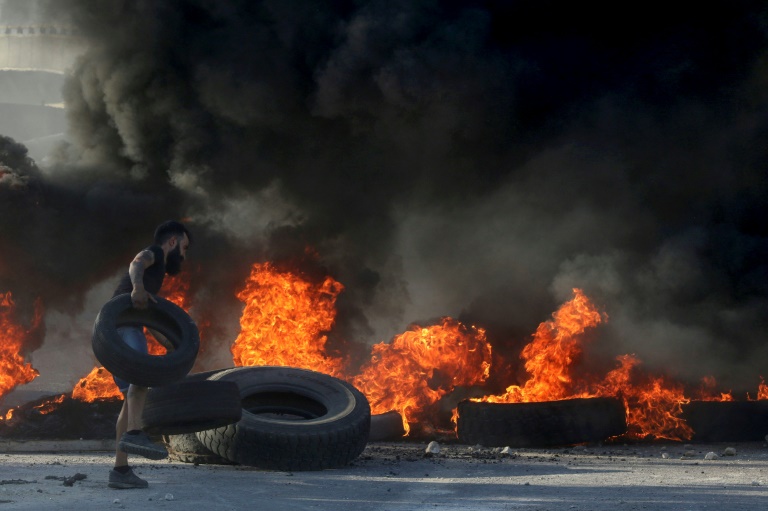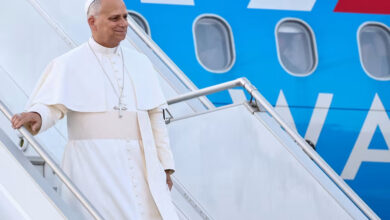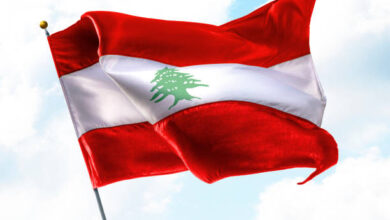
Hundreds protested for a second night over the Lebanese authorities’ handling of a deepening economic crisis, despite the government pledging on Friday to inject dollars into the market to bolster the sagging currency.
In one incident in central Beirut, roughly 200 young men gathered on mopeds, some of them defacing shop fronts and setting fire to stores. Some chanted against sectarianism.
Security forces fired tear gas to disperse them and some of the young men threw stones and fire crackers back. Tension petered out after midnight.
In the northern city of Tripoli, the army dispersed hundreds shouting “revolution, revolution”.
Demonstrators had thrown stones and Molotov cocktails toward the soldiers and damaged the facades of several banks and shops. Soldiers responded with tear gas.
After a crisis meeting on Friday, President Michel Aoun announced that the central bank would implement measures from Monday including “feeding dollars into the market”, in a bid to support the Lebanese pound.
But 17-year-old Wael, protesting in Tripoli, was not impressed: “I just want a job so I can live. We don’t believe all the measures taken by the government to improve the dollar exchange rate.”
Lebanese media reported that the exchange rate had tumbled to 6,000 per dollar on the black market early on Friday, compared to the official peg of 1,507 in place since 1997.
Protesters had initially taken to the streets after sundown on Thursday, railing against the spiralling cost of living and the government’s apparent impotence in the face of the worst economic turmoil since the 1975-1990 civil war.
They had also rallied against the governor of the central bank, Riad Salame.
– Central bank chief under fire –
Parliament Speaker Nabih Berri, who attended Friday’s meeting with the president alongside Prime Minister Hassan Diab, said the government’s measures aimed to bring the exchange rate to stronger than 4,000 pounds to the dollar.
The black market rate had appreciated to below 4,500 on Friday evening after the president’s announcement, two dealers said.
Tensions have grown recently between the government, which is backed by Shiite movement Hezbollah, and the central bank’s governor.
Experts say the cabinet would like to see Salame removed from the position he has held since 1993.
Protesters accuse him of having encouraged state borrowing over the decades that they say benefited only the banking and political elite.
Anger against banks has risen in recent months, after they banned all transfers abroad and gradually restricted dollar withdrawals, forcing those in need to buy the greenback at unattractive rates on the black market.
“Several currents taking part in the protests want to topple the central bank governor and hold him accountable for the financial” crisis, among them Hezbollah, Lebanese American University professor Imad Salamey told AFP.
Hezbollah supporters joined the demonstrations late Thursday, despite usually being against the protest movement that began in October.
The previous government stepped down under street pressure just weeks into the demonstrations that began in October, and Diab’s cabinet began work earlier this year.
– ‘Middle class obliterated’ –
“The economic situation has further deteriorated… The middle class has been obliterated,” said Hilal Khashan, a professor at the American University of Beirut.
“But I don’t think the government will collapse.”
The central bank late Thursday hit out at “baseless” information on social media of “exchange rates at levels far from reality, which mislead citizens”.
Lebanon — one of the most indebted countries in the world with a sovereign debt of more than 170 percent of its GDP — went into default in March.
It started talks with the International Monetary Fund last month in a bid to unlock billions of dollars in financial aid. Dialogue is ongoing.
Unemployment has soared to 35 percent nationwide.
The country enforced a lockdown in mid-March to stem the spread of the novel coronavirus, dealing a further blow to businesses.
Lebanon has recorded some of the pandemic’s best declared metrics in the Middle East, with just 1,422 cases of COVID-19, including 31 deaths.
Image: AFP / Mahmoud ZAYYAT A Lebanese protester on a highway amid new demonstrations in multiple locations on Friday, in this instance in the southern coastal town of Ghazieh




